Abstract
Thyrotropin-releasing hormone (TRH) stimulates prolactin production by GH4C1 rat pituitary tumor cells, which possess high-affinity membrane receptors for the peptide. TRH caused up to a 50% increase in the activity of a low-Km GTPase in membranes from GH4C1 cells. The TRH stimulatory effect was maximal at GTP concentrations of 1 microM or lower. TRH caused an increase in GTPase activity of between 0.2 and 20 pmol of GTP hydrolyzed per mg of protein per min, depending on GTP concentration, while TRH binding was 0.3 pmol/mg of protein. TRH did not stimulate GTPase activity in membranes from GH12C1, or GH-Y cells, two pituitary lines lacking TRH receptors. Stimulation of GTPase depended on occupancy of the TRH receptor; half-maximal increases in GTPase activity required 46 nM TRH and 25 nM [N3-methyl-His]TRH, but the TRH free acid was inactive. The apparent Kds of these peptides for receptors were similar when measured under the same conditions. The fact that TRH binding to receptors is regulated by guanyl nucleotides, together with the demonstration of TRH stimulation of low-Km GTPase activity, suggests that the TRH receptor is associated with a guanyl nucleotide regulatory protein in the lactotroph membrane.
Full text
PDF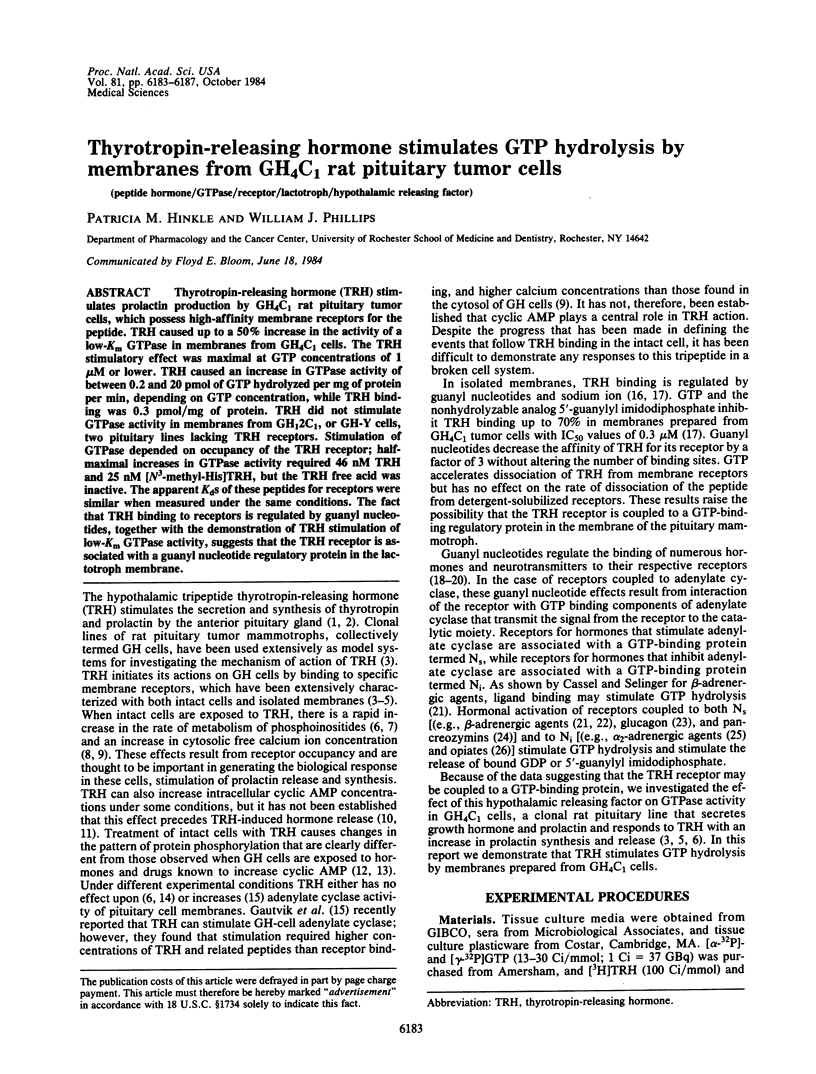
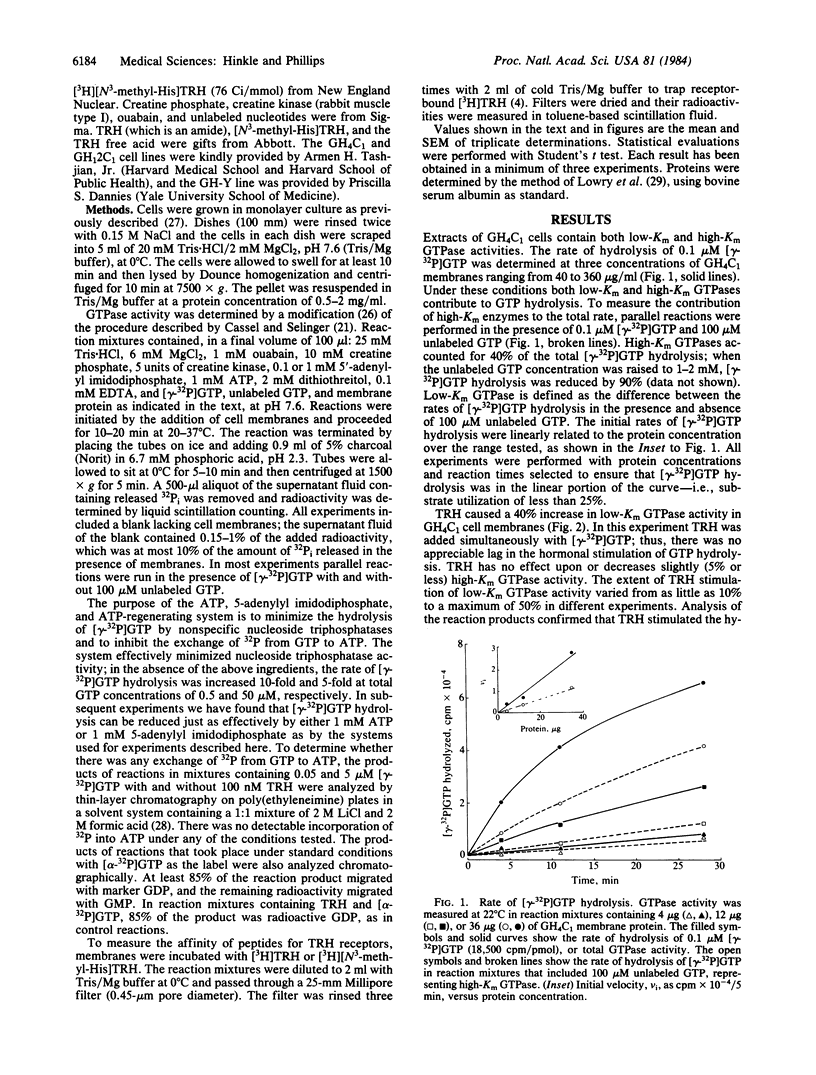
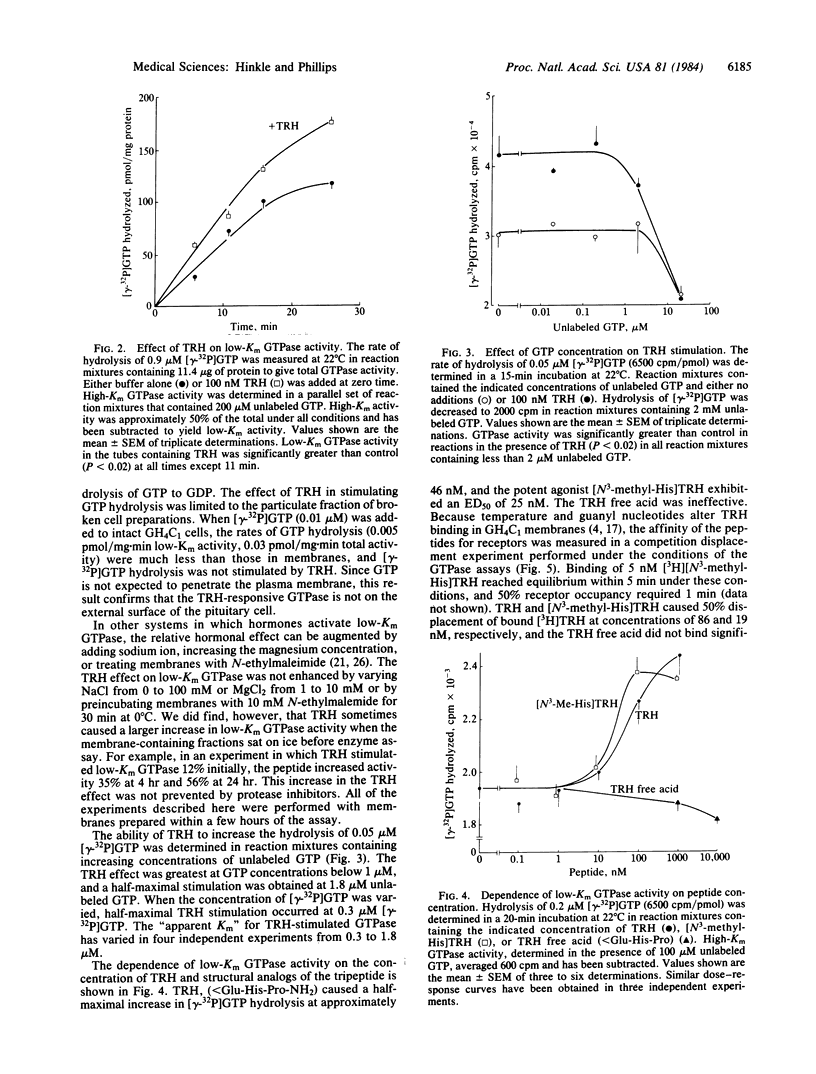
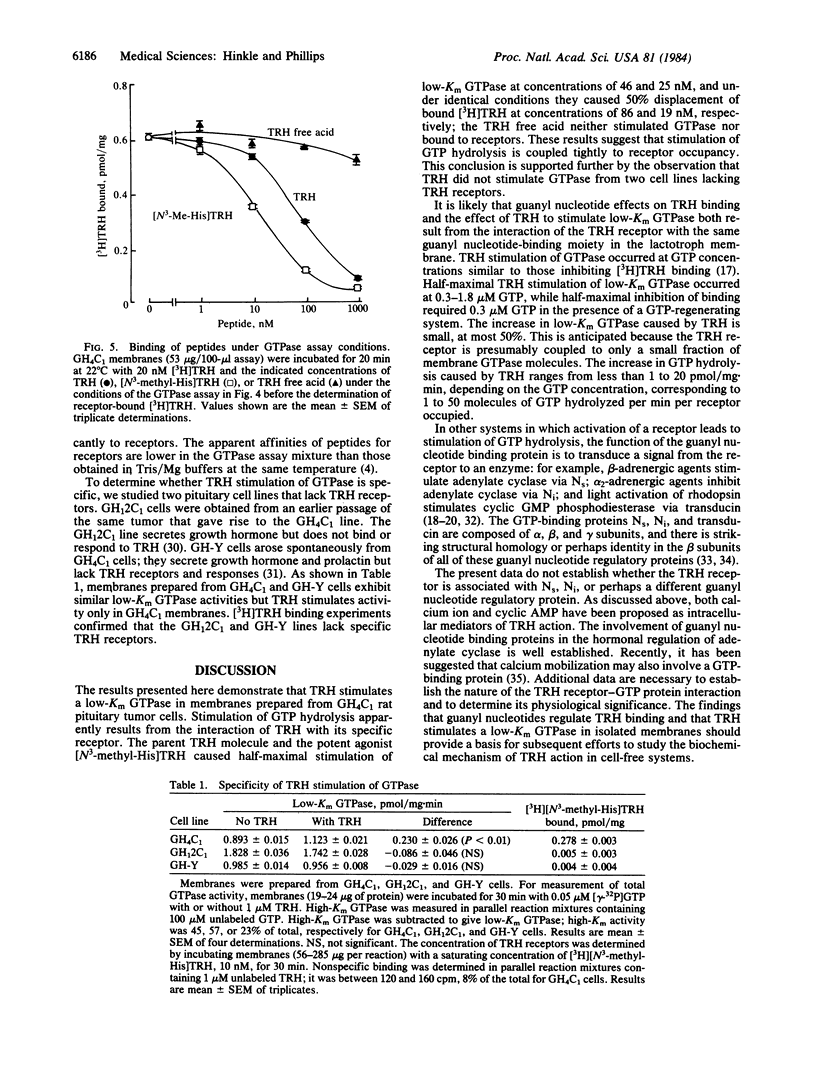
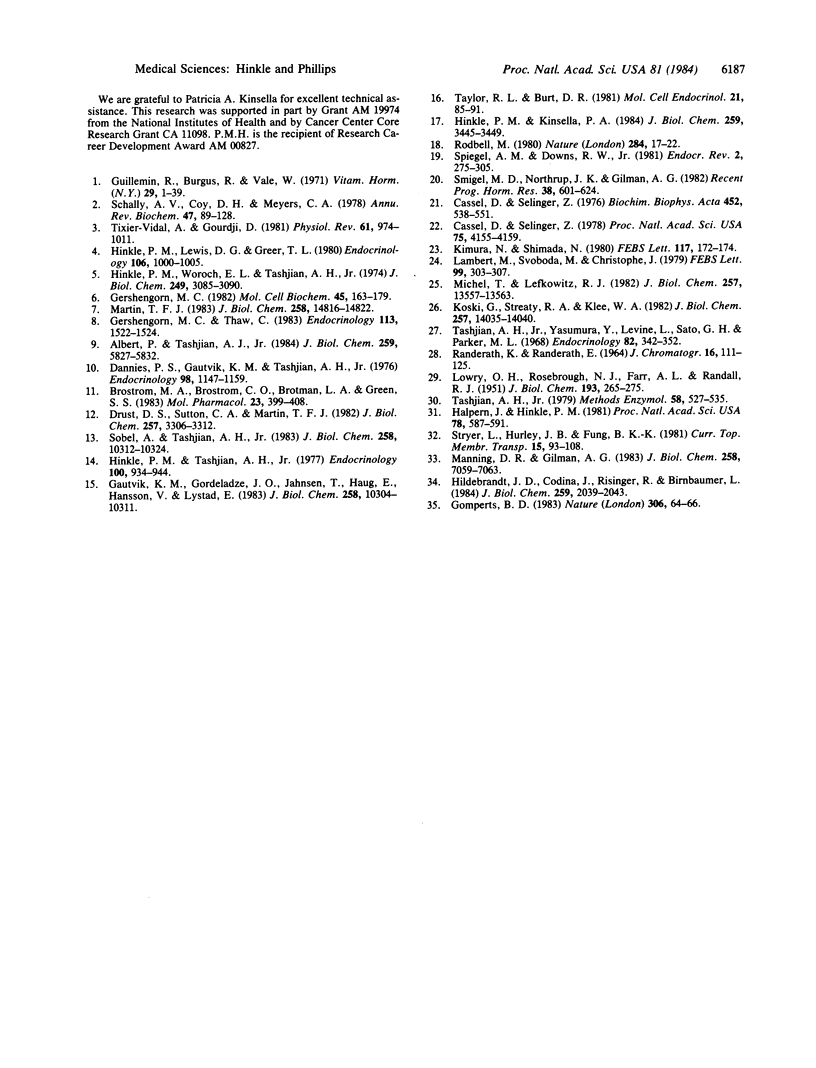
Selected References
These references are in PubMed. This may not be the complete list of references from this article.
- Albert P. R., Tashjian A. H., Jr Thyrotropin-releasing hormone-induced spike and plateau in cytosolic free Ca2+ concentrations in pituitary cells. Relation to prolactin release. J Biol Chem. 1984 May 10;259(9):5827–5832. [PubMed] [Google Scholar]
- Brostrom M. A., Brostrom C. O., Brotman L. A., Green S. S. Regulation of Ca2+-dependent cyclic AMP accumulation and Ca2+ metabolism in intact pituitary tumor cells by modulators of prolactin production. Mol Pharmacol. 1983 Mar;23(2):399–408. [PubMed] [Google Scholar]
- Cassel D., Selinger Z. Catecholamine-stimulated GTPase activity in turkey erythrocyte membranes. Biochim Biophys Acta. 1976 Dec 8;452(2):538–551. doi: 10.1016/0005-2744(76)90206-0. [DOI] [PubMed] [Google Scholar]
- Cassel D., Selinger Z. Mechanism of adenylate cyclase activation through the beta-adrenergic receptor: catecholamine-induced displacement of bound GDP by GTP. Proc Natl Acad Sci U S A. 1978 Sep;75(9):4155–4159. doi: 10.1073/pnas.75.9.4155. [DOI] [PMC free article] [PubMed] [Google Scholar]
- Dannies P. S., Gautvik K. M., Tashjian A. H., Jr A possible role of cyclic AMP in mediating the effects of thyrotropin-releasing hormone on prolactin release and on prolactin and growth hormone synthesis in pituitary cells in culture. Endocrinology. 1976 May;98(5):1147–1159. doi: 10.1210/endo-98-5-1147. [DOI] [PubMed] [Google Scholar]
- Drust D. S., Sutton C. A., Martin T. F. Thyrotropin-releasing hormone and cyclic AMP activate distinctive pathways of protein phosphorylation in GH pituitary cells. J Biol Chem. 1982 Mar 25;257(6):3306–3312. [PubMed] [Google Scholar]
- Gautvik K. M., Gordeladze J. O., Jahnsen T., Haug E., Hansson V., Lystad E. Thyroliberin receptor binding and adenylyl cyclase activation in cultured prolactin-producing rat pituitary tumor cells (GH cells). J Biol Chem. 1983 Sep 10;258(17):10304–10311. [PubMed] [Google Scholar]
- Gershengorn M. C., Thaw C. Calcium influx is not required for TRH to elevate free cytoplasmic calcium in GH3 cells. Endocrinology. 1983 Oct;113(4):1522–1524. doi: 10.1210/endo-113-4-1522. [DOI] [PubMed] [Google Scholar]
- Gershengorn M. C. Thyrotropin releasing hormone. A review of the mechanisms of acute stimulation of pituitary hormone release. Mol Cell Biochem. 1982 Jun 25;45(3):163–179. doi: 10.1007/BF00230085. [DOI] [PubMed] [Google Scholar]
- Gomperts B. D. Involvement of guanine nucleotide-binding protein in the gating of Ca2+ by receptors. Nature. 1983 Nov 3;306(5938):64–66. doi: 10.1038/306064a0. [DOI] [PubMed] [Google Scholar]
- Guillemin R., Burgus R., Vale W. The hypothalamic hypophysiotropic thyrotropin-releasing factor. Vitam Horm. 1971;29:1–39. doi: 10.1016/s0083-6729(08)60046-1. [DOI] [PubMed] [Google Scholar]
- Halpern J., Hinkle P. M. Direct visualization of receptors for thyrotropin-releasing hormone with a fluorescein-labeled analog. Proc Natl Acad Sci U S A. 1981 Jan;78(1):587–591. doi: 10.1073/pnas.78.1.587. [DOI] [PMC free article] [PubMed] [Google Scholar]
- Hildebrandt J. D., Codina J., Risinger R., Birnbaumer L. Identification of a gamma subunit associated with the adenylyl cyclase regulatory proteins Ns and Ni. J Biol Chem. 1984 Feb 25;259(4):2039–2042. [PubMed] [Google Scholar]
- Hinkle P. M., Kinsella P. A. Regulation of thyrotropin-releasing hormone binding by monovalent cations and guanyl nucleotides. J Biol Chem. 1984 Mar 25;259(6):3445–3449. [PubMed] [Google Scholar]
- Hinkle P. M., Lewis D. G., Greer T. L. Thyrotropin-releasing hormone-receptor interaction in GH3 pituitary cells. Endocrinology. 1980 Mar;106(3):1000–1005. doi: 10.1210/endo-106-3-1000. [DOI] [PubMed] [Google Scholar]
- Hinkle P. M., Tashjian A. H., Jr Adenylyl cyclase and cyclic nucleotide phosphodiesterases in GH-Strains of rat pituitary cells. Endocrinology. 1977 Apr;100(4):934–944. doi: 10.1210/endo-100-4-934. [DOI] [PubMed] [Google Scholar]
- Hinkle P. M., Woroch E. L., Tashjian A. H., Jr Receptor-binding affinities and biological activities of analogs of thyrotropin-releasing hormone in prolactin-producing pituitary cells in culture. J Biol Chem. 1974 May 25;249(10):3085–3090. [PubMed] [Google Scholar]
- Kimura N., Shimada N. Glucagon-stimulated GTP hydrolysis in rat liver plasma membranes. FEBS Lett. 1980 Aug 11;117(1):172–174. doi: 10.1016/0014-5793(80)80938-0. [DOI] [PubMed] [Google Scholar]
- Koski G., Streaty R. A., Klee W. A. Modulation of sodium-sensitive GTPase by partial opiate agonists. An explanation for the dual requirement for Na+ and GTP in inhibitory regulation of adenylate cyclase. J Biol Chem. 1982 Dec 10;257(23):14035–14040. [PubMed] [Google Scholar]
- LOWRY O. H., ROSEBROUGH N. J., FARR A. L., RANDALL R. J. Protein measurement with the Folin phenol reagent. J Biol Chem. 1951 Nov;193(1):265–275. [PubMed] [Google Scholar]
- Lambert M., Svoboda M., Christophe J. Hormone-stimulated GTPase activity in rat pancreatic plasma membranes. FEBS Lett. 1979 Mar 15;99(2):303–307. doi: 10.1016/0014-5793(79)80978-3. [DOI] [PubMed] [Google Scholar]
- Manning D. R., Gilman A. G. The regulatory components of adenylate cyclase and transducin. A family of structurally homologous guanine nucleotide-binding proteins. J Biol Chem. 1983 Jun 10;258(11):7059–7063. [PubMed] [Google Scholar]
- Martin T. F. Thyrotropin-releasing hormone rapidly activates the phosphodiester hydrolysis of polyphosphoinositides in GH3 pituitary cells. Evidence for the role of a polyphosphoinositide-specific phospholipase C in hormone action. J Biol Chem. 1983 Dec 25;258(24):14816–14822. [PubMed] [Google Scholar]
- Michel T., Lefkowitz R. J. Hormonal inhibition of adenylate cyclase. alpha 2 Adrenergic receptors promote release of [3H]guanylylimidodiphosphate from platelet membranes. J Biol Chem. 1982 Nov 25;257(22):13557–13563. [PubMed] [Google Scholar]
- RANDERATH K., RANDERATH E. ION-EXCHANGE CHROMATOGRAPHY OF NUCLEOTIDES ON POLY-(ETHYLENEIMINE)-CELLULOSE THIN LAYERS. J Chromatogr. 1964 Oct;16:111–125. doi: 10.1016/s0021-9673(01)82445-6. [DOI] [PubMed] [Google Scholar]
- Rodbell M. The role of hormone receptors and GTP-regulatory proteins in membrane transduction. Nature. 1980 Mar 6;284(5751):17–22. doi: 10.1038/284017a0. [DOI] [PubMed] [Google Scholar]
- Schally A. V., Coy D. H., Meyers C. A. Hypothalamic regulatory hormones. Annu Rev Biochem. 1978;47:89–128. doi: 10.1146/annurev.bi.47.070178.000513. [DOI] [PubMed] [Google Scholar]
- Smigel M. D., Northup J. K., Gilman A. G. Characteristics of the guanine nucleotide-binding regulatory component of adenylate cyclase. Recent Prog Horm Res. 1982;38:601–624. doi: 10.1016/b978-0-12-571138-8.50019-6. [DOI] [PubMed] [Google Scholar]
- Sobel A., Tashjian A. H., Jr Distinct patterns of cytoplasmic protein phosphorylation related to regulation of synthesis and release of prolactin by GH cells. J Biol Chem. 1983 Sep 10;258(17):10312–10324. [PubMed] [Google Scholar]
- Spiegel A. M., Downs R. W., Jr Guanine nucleotides: key regulators of hormone receptor-adenylate cyclase interaction. Endocr Rev. 1981 Summer;2(3):275–305. doi: 10.1210/edrv-2-3-275. [DOI] [PubMed] [Google Scholar]
- Tashjian A. H., Jr Clonal strains of hormone-producing pituitary cells. Methods Enzymol. 1979;58:527–535. doi: 10.1016/s0076-6879(79)58167-1. [DOI] [PubMed] [Google Scholar]
- Tashjian A. H., Jr, Yasumura Y., Levine L., Sato G. H., Parker M. L. Establishment of clonal strains of rat pituitary tumor cells that secrete growth hormone. Endocrinology. 1968 Feb;82(2):342–352. doi: 10.1210/endo-82-2-342. [DOI] [PubMed] [Google Scholar]
- Taylor R. L., Burt D. R. Guanine nucleotides modulate TRH-receptor binding in sheep anterior pituitary. Mol Cell Endocrinol. 1981 Jan;21(1):85–91. doi: 10.1016/0303-7207(81)90033-2. [DOI] [PubMed] [Google Scholar]
- Tixier-Vidal A., Gourdji D. Mechanism of action of synthetic hypothalamic peptides on anterior pituitary cells. Physiol Rev. 1981 Oct;61(4):974–1011. doi: 10.1152/physrev.1981.61.4.974. [DOI] [PubMed] [Google Scholar]


